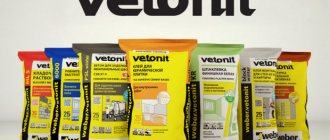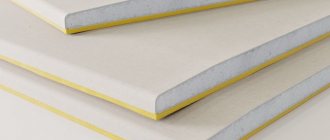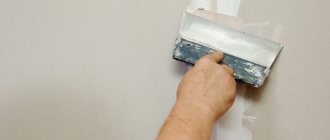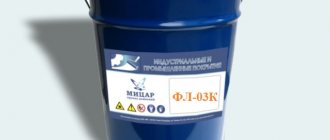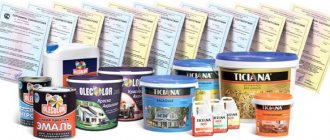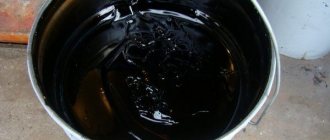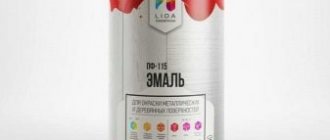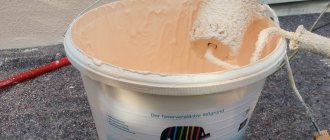Currently, plastering work is regulated by the Code of Practice SP 71.13330.2017 “Insulating and finishing coatings”. This document is an updated version of SNiP 3.04.01-87. GOST for plaster is not currently used.
The set of rules SP 71.13330.2017 was approved by the Ministry of Construction and Housing and Communal Services and contains rules and general principles regarding processes in order to ensure compliance with the requirements of technical regulations.
SNiP stands for “Building Norms and Rules” - it is a regulatory and technical document in the field of standardization that regulates the implementation of urban planning activities, engineering surveys, architectural and construction design, and construction in a certain area of work.
A code of practice is a normative document that recommends technical solutions or engineering survey procedures for construction, design, construction and installation work and the manufacture of construction products, as well as the operation of construction products and determines ways to achieve their compliance with the mandatory requirements of building codes, regulations and standards.
Preface
1 DEVELOPED by the Association "Union of Producers of Dry Construction Mixes" (Association "SPSSS") with the participation of the Federal State Budgetary Educational Institution of Higher Education "National Research Moscow State Construction University" (NRU MGSU)
2 INTRODUCED by the Technical Committee for Standardization TC 144 “Building materials (products) and structures”
3 APPROVED AND ENTERED INTO EFFECT by Order of the Federal Agency for Technical Regulation and Metrology dated December 28, 2022 No. 1189-st
4 INTRODUCED 8FIRST
The rules for applying this standard are established in Article 26 of the Federal Law of June 29, 2015 N9 162-FZ “On Standardization in the Russian Federation”. Information about changes to this standard is published in the annual (as of January 1 of the current year) information index “National Standards”, and the official text of changes and amendments is published in the monthly information index “National Standards”. In case of revision (replacement) or cancellation of this standard, the corresponding notice will be published in the next issue of the monthly information index “National Standards”. Relevant information, notices and texts are also posted in the public information system - on the official website of the Federal Agency for Technical Regulation and Metrology on the Internet (www.gost.ru)
© Staydarinform. decor. 2019
This standard cannot be fully or partially reproduced, replicated or distributed as an official publication without permission from the Federal Agency for Technical Regulation and Metrology
II
SNiP plaster. Code of Practice (SP)
In SP 71.13330.2017, the requirements for plastering work are specified in Chapter 7 “Finishing work”. This document is, in fact, the main joint venture for finishing work, and applies to both internal and external work, including plastering the base and facade. It defines the requirements for work technology, the presence and control of errors in plastering, tolerances and defects in plaster.
Below are the main extracts from this document regarding plastering work.
7.1.1 Finishing work in premises should be carried out at an ambient temperature and surfaces to be finished from 5°C to 30°C, relative air humidity no more than 60%, unless otherwise specified by the material manufacturer. This temperature and humidity regime in the room must be maintained around the clock during the entire period of finishing work and at least 2 days before the start and 12 days after the completion of work.
7.1.8 Before applying each subsequent layer, it is necessary to remove dust from the surface being treated and, if necessary, treat the base with a primer to reduce or level its absorbency.
7.2.6 Plaster mortar based on cement or lime-cement binder can be applied either in one layer or in layers according to the instructions of the material manufacturer. When installing a multi-layer plaster coating, each layer must be applied after the previous one has set. Depending on the type of work, the plaster mortar, the type of base, the unevenness of the wall and the thickness of the layer, if provided for by the project, a plaster mesh is selected, if necessary, and attached to the wall.
7.2.7 When performing internal plastering work with gypsum-based solutions, it is allowed to carry out work without using a plaster mesh. Gypsum-based plaster solutions are applied in one layer, unless otherwise specified by the material manufacturer.
7.2.13 The quality of plastering work is assessed according to the requirements:
| Simple plaster | Improved plaster | High quality plaster | |
| Deviation from vertical | No more than 3 mm per 1 m, but no more than 10 mm over the entire height of the room | No more than 2 mm per 1 m, but no more than 10 mm over the entire height of the room | No more than 0.5 mm per 1 m, but no more than 5 mm over the entire height of the room |
| Horizontal deviation | No more than 3 mm per 1 m | No more than 3 mm per 1 m | No more than 1 mm per 1 m |
| Surface irregularities of a smooth outline | No more than 4 pcs. per 1 m, but not more than 10 mm for the entire element | No more than 2 pieces, depth (height) up to 3 mm | No more than 2 pcs., depth (height) up to 1 mm |
| Deviation of window and door slopes, pilasters, pillars, etc. from vertical and horizontal | No more than 4 mm per 1 m, but no more than 10 mm for the entire element | On area 4 no more than 4 mm per 1 m, but no more than 10 mm for the entire element | On area 4 no more than 2 mm per 1 m, but no more than 5 mm for the entire element |
| Deviation of the radius of curved surfaces from the design value | No more than 10 mm for the entire element | No more than 7 mm for the entire element | No more than 4 mm for the entire element |
| Deviation of slope width from design | No more than 5 mm | No more than 3 mm | No more than 2 mm |
Read more about each type of plaster according to SP in the articles: simple, improved and high-quality plaster. In addition to the requirements for deviations and tolerances, there is a difference in the technology of work. Simple plastering can be done without beacons, but for improved and high-quality plaster it is necessary to use beacon profiles.
The requirements of SP 71.13330.2017 regarding the quality of plastering work correspond to the German standard for plaster DIN V 18550 “Plaster and plastering systems”. This European Standard contains a set of recommendations for the preparation and assessment of surface quality depending on the different types of finishing coatings from the lowest Q1 to the highest Q4.
In addition to the current Code of Practice, there is a draft National Standard of the Russian Federation GOST R 57984-2017/EN 13914-1:2005 “Plaster for external and internal work. Rules for selection, preparation and application. Part 1. Plasters for external work”, but at the moment this document has not come into force.
Advantages and disadvantages of gypsum cladding
The basis for this type of composition is gypsum. It is obtained from a natural mineral, which is crushed after prolonged heat treatment. The quality of the treated surface depends on the degree of its grinding. The larger the fraction, the larger the irregularities it can cover. In addition, the material contains natural and synthetic fillers. They improve ductility, increase adhesion, etc.
The general advantages of gypsum solutions are:
- Plastic. Easy to apply, level and smooth. After drying it does not crack.
- Good leveling ability. After applying the mixture, the surface is ready for finishing.
- Possibility of applying a thick layer up to 60 mm.
- A small consumption rate, provided that the application technology is strictly followed.
- High curing speed. On average, it takes no more than a week for the mixture to fully gain strength. Finishing work can be continued within a day.
- Good adhesion to any surfaces.
- Vapor permeability. The surface does not lose its ability to “breathe”.
- Light weight. No additional strengthening of walls or partitions is required.
GOST plaster
There are various GOST standards for plaster mixtures depending on the main component (binder) in the composition:
- GOSTR 57957-2017/EN 13279-1:2008 Gypsum binders and plaster;
- GOSTR 57336-2016/EN 998-1:2010 Construction plaster mortars (for lime binder);
- GOST 31357-2007. Dry building mixtures based on cement binder.
These GOST standards are mainly used in the production of mixtures in industrial conditions. In addition, some manufacturers produce plaster mixtures in accordance with the Technical Specifications (TU).
6 Acceptance rules
6.1 Acceptance of dry plaster mixtures is carried out in accordance with the requirements of GOST 31357 and this standard.
6.2 The volume of the batch is established in agreement with the consumer, but not more than the daily output of the mixing plant.
6.3 During acceptance tests of each batch of mixtures, the moisture content, the largest grain size of the aggregate and the content of the largest grain size for dry mixtures, the mobility and water-holding capacity of freshly prepared plaster mixtures are determined.
If unsatisfactory results of acceptance tests are obtained for at least one indicator, repeat tests are carried out on a double quantity of products taken from the same batch. The results of repeated tests are final and apply to the entire batch.
A batch of plaster mixture is rejected if the mixture does not meet the requirements of this standard in at least one indicator.
6.4 During periodic testing, the following is determined: retention of initial mobility, compressive strength, adhesion strength to the base, average density - at least once a month; vapor permeability, resistance to cracking and impact, frost resistance, frost resistance of the contact zone, shrinkage deformation (expansion), delamination, capillary water absorption, thermal conductivity - at least once every 6 months, as well as when changing the quality of source materials, mixture composition and technology manufacturing.
The results of periodic tests apply to all supplied batches of dry mixtures until the next periodic tests are carried out.
6.5 Radiation-hygienic assessment of mixtures may be carried out on the basis of passport data from suppliers of mineral materials used for the manufacture of mixtures on the content of natural radionuclides in these materials.
In the absence of supplier data on the content of natural radionuclides in the starting materials, the manufacturer of the mixtures at least once a year, as well as with each change of supplier, determines the content of natural radionuclides in the materials and/or mixture.
6.6 The consumer has the right to carry out quality control checks of mixtures in accordance with the requirements and methods established in this standard.
6.7 Each batch of the supplied mixture must be accompanied by a quality document indicating:
— name of the manufacturing enterprise;
— name and symbol of the mixture;
— batch number;
— number and date of issue of the quality document;
— batch volume, kg (t);
— values of the main indicators of the quality of mixtures;
— specific effective activity of natural radionuclides of the plaster mixture;
- designation of a regulatory or technical document in accordance with which the plaster mixture is produced.
During export-import operations, the content of the quality document is specified in the contract for the supply of dry mixture.
Work progress
Installing tiles on a gypsum base is practically no different from laying tiles on cement-sand plaster.
- Before starting work, markings are made. The approximate location of the tiles can be marked on paper and then on the wall. At this stage, you can install beacons. Do not forget about the presence of seams between the tiles. To mark straight horizontal and vertical lines, you can use a plumb line and level.
Marking the lighthouse under the tiles.
Marking can be conveniently done using a laser level or a thread punch.
- When calculating the height of the tiles, do not leave the halves to join the ceiling, this will spoil the appearance of the room.
- When choosing tile adhesive, it is important to choose a composition based on gypsum binder. The glue must have an elastic consistency and provide good adhesion. Avoid using cementitious compounds as the tiles may collapse in the future.
Mixing tile adhesive using a mixer.
- The glue is applied to the wall in a small layer. If you also apply the solution to the tile itself, the weight of the finishing coating will increase, and this is fraught with consequences. To minimize the thickness of the adhesive layer, use a notched trowel to make furrows.
- You should not put any stress on gypsum plaster, so all procedures for sawing or drilling tiles should be done before fixing them to the wall. The tiles are mounted on the wall according to the markings. After completing the work, the surface should be washed from any glue residue.
Tile adhesive is diluted in a container with water added. It is convenient to use a drill mixer for stirring. After this, you need to give the solution time so that it has time to acquire the desired consistency.
Requirements for the quality of the plaster compositions used
Quality control of the material and mortar used is carried out on the basis of GOST 28013-98 “Building mortars. General technical conditions".
According to GOST, a solution for improved plaster must meet the following requirements:
- The solution intended for spraying and soil must pass through a mesh with a mesh diameter of 3 mm.
- The solution for the covering layer must pass through a mesh that has a mesh size of 1.5 mm.
- The sand used to prepare the solution must contain grains whose size does not exceed 2.5 mm in solutions for primer and spray and 1.25 mm for finishing.
- GOST also regulates technical parameters such as mobility, delamination, water retention and strength.
Dry mixes
Dry building mixtures "Master"
General construction dry building mixtures of the Master brand are sold in bags of strictly 50 kg, modified mixtures in packages of 25, 30 kg.
Master dry mixes are a non-shrinking dry mortar building mixture with a complex of specially selected mineral additives and organic plasticizers.
Prices are indicated for a one-time shipment of 20 tons, excluding delivery costs. Our managers will adjust for you the optimal cost of delivery to your facility. Delivery is carried out by road to the central regions of Russia.
Regular customers receive discounts up to 20%. All taxes are included in the price of the product.
5 Safety and environmental requirements
5.1 Dry plaster mixtures are non-flammable, fire and explosion-proof materials.
5.2 The sanitary and radiation-hygienic safety of using mixtures is assessed by the safety of the mixtures or their components.
The safety of mineral components of mixtures (cement, aggregates, fillers, pigments) is assessed by the content of radioactive substances, chemical additives - by their sanitary and hygienic characteristics.
5.3 Mixtures should not release harmful chemicals into the external environment in quantities exceeding maximum permissible concentrations (MPCs) approved by health authorities.
5.4 It is prohibited to discharge dry mixtures, as well as waste from equipment washing into water bodies for sanitary use and sewerage.
Application
- Before finishing, the surfaces are primed.
- The cement mortar is spread with a trowel and then leveled. They also work with plaster. Both types of mortar can be applied manually or mechanically.
- Cement maintains its consistency during application and distribution; gypsum must be produced quickly before the material sets.
- When working with both types of mixtures, it is necessary to maintain a positive temperature in the premises - from +5°C. The same rule applies to outdoor work.
vote
Article rating
